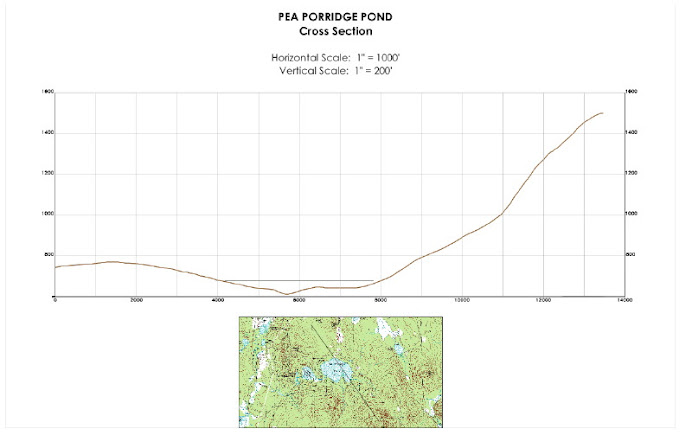To explore the composition of the plankton community responsible for the "positive heterograde" dissolved oxygen curve (see Scientific Posting No. 20), a 10 minute plankton tow was taken along a mid-lake transect with the net weighted to tow at a depth of ca 10 feet. Here is an annotated listing of some members of the plankton community at Big Pea Porridge Pond in Madison, NH, August, 2008
PHYTOPLANKTON = the microscopic, unicellular or colonial PLANT (or in one case bacterial) component of the plankton community.
Division: Cyanobacteria – blue-green bacteria
Anabaena : Chain of beads, including an occasional, larger "bead" known as a heterocyst. This is the site of nitrogen-fixation. This genus can become overly productive blooms and cause water quality problems. The neat thing about Anabaena in Big PPP is that it was not at all abundant. However, it formed some tiny ball-like masses to which a form of stalked ciliate protozoa, Vorticella-like, was attached. The beating of the cilia to create feeding currents by the Vorticella also propelled the entire colony around through the water – presumably an asset to Anabaena by bringing it to fresh nutrients and reducing its sinking rate in the water column.
Division: Crysophyta – golden-brown algae
Dinobryon: Colonial. Vase-shaped case or lorica, each with two flagella to provide some mobility to the colony. When abundant, Dinobryon sertularia gives a fishy taste to the water.
Diatoma: Colonial diatom.
Division: Chlorophyta – green algae
Asterionella – star shaped colonies. Individuals are glued to one another at one end by mucilage.
Micractinium – small spherical cells with projecting spines to aid with floatation.
Division: Pyrrhophyta – dinoflagellates
Ceratium – armor plated cell with 3 long projecting spines that assist in floatation. They are "mixotrophic", i.e., they both photosynthesize like a plant and phagocytize, eating other organisms, like an animal.
ZOOPLANKTON = the microscopic, unicellular ANIMAL component of the plankton community.
Phylum: Rotifera
Asplanchna – large sac-like rotifer. Feeds on algae and bacteria. Its presence here suggests productivity is more towards the oligotrophic side. It also suggests that pH of Big PPP is usually at or above 7 (neutrality).
Keratella feed on algae and microorganisms. They tend to have two population maxima – one in the spring and a second in the summer. They live for about 3 weeks – longer than many rotifers whose lifespan in measured in days. They tend to be associated with oligotrophic waters.
Kellicotia longispina – with 4 long spines that assist with buoyancy – slowing its sinking rate. They are typically in oligotrophic waters and have a single mid-summer population maximum.
Phylum: Arthropoda Subphylum: Crustacea Class: Malacostraca
Order: Cladocera ("water fleas")
There are illustrations and descriptions of each of these water flea species at: http://ilmbwww.gov.bc.ca/risc/pubs/aquatic/crustacea/
Bosmina longirostrus A small, substrate-dwelling type with antennae modified to form an "elephant trunk"-like projection. The remains of exoskeletons of this type of water flea are the most common objects of animal origin found in our deep core samples from the past.
Daphnia longiremis Their egg cases or ephippia are among the items that remain well preserved in the sediments thousands of years old in our core samples. An indicator species for cold, oligotrophic waters.
Holopedium – has an inflated body covering encased in a large gelatinous coating. Uniquely among water fleas, it swims ventral side up. It tends to be associated with lakes tending toward the acid side of the pH scale, so it's presence in Big PPP clashes a bit with the rotifer Asplanchna. An indicator species for cold, oligotrophic waters.
Leptodora – a large (up to 18 mm) and bizarre water flea with enlarged, wing-like second antennae and legs adapted for capturing rotifers and other plankton.
Phylum: Arthropoda Subphylum: Crustacea Class: Malacostraca
Order: Copepoda
Cyclopoid copepods: club-shaped body with curved antennae or moderate length. Some are predatory, others are grazers. Undoubtedly several species.
Calanoid copepods: torpedo-shaped body with long straight antennae. Algal filter-feeders. At least two species – including one bearing conspicuous orange droplets of oil-storage reserved. This species is often associated with acidified waters.
Nauplius larva: only three-pairs of appendages. Undergo six growth stages or moults. Life cycle lasts 5-6 months.
As a rough indication of the relative abundance of these members of the plankton community at Big Pea Porridge Pond in late August, 2008, the following lists numbers observed in a 5 cc sample from a 10 minute plankton tow at 10 foot depth.
Phytoplankton (# of colonies)
300 Dinobryon slender
10 Dinobryon sertularia
600 Micractinium
60 Asterionella
80 Diatoma
10 Ceratium (individuals)
2 Anabaena
Rotifera
1 Dichoerca
24 Keratella
2 Asplanchna
4 Kellicottia
Cladocera
1 Leptodora kindtii
8 Holopedium gibberum
19 Diaphanosoma brachyurum
4 Daphnia pulcaria?
3 Bosmina longirostrus
17 Ceriodaphnia reticulata
Copepoda
61 Calanoid copepods
49 Cyclopoid copepods
(Click on the image below to be linked to a slideshow of more images of community members)
 |
| From Scientific Posting #21 |
Lee Pollock



No comments:
Post a Comment